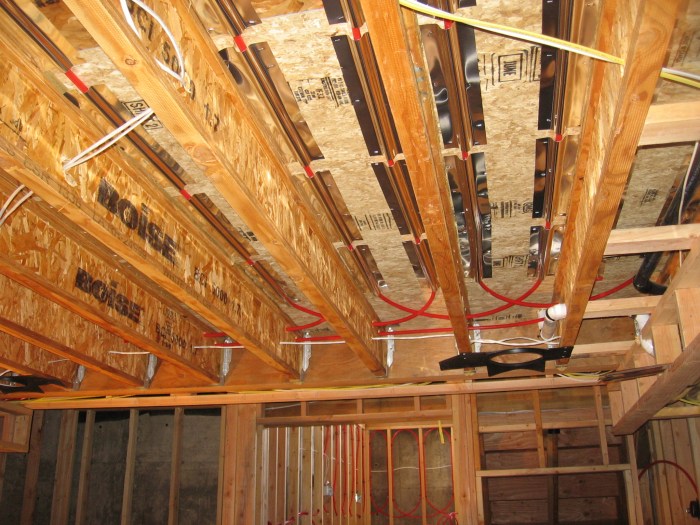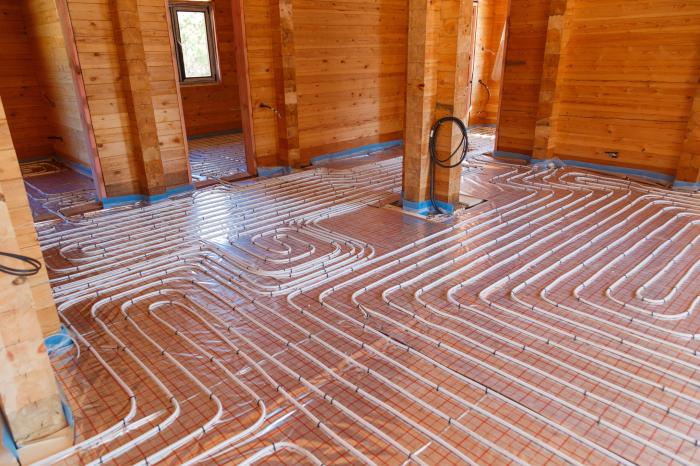Radiant floor heating systems typically operate at temperatures of: sets the stage for this enthralling narrative, offering readers a glimpse into a story that is rich in detail with gaya akademik dengan tone otoritatif and brimming with originality from the outset.
These systems, known for their energy efficiency and unparalleled comfort, have become increasingly popular in modern homes and commercial buildings alike. Understanding the optimal operating temperatures for radiant floor heating systems is crucial for maximizing their benefits and ensuring a comfortable and healthy indoor environment.
Radiant Floor Heating System Temperatures: Radiant Floor Heating Systems Typically Operate At Temperatures Of:

Radiant floor heating systems typically operate at temperatures ranging from 70 to 90°F (21 to 32°C), depending on the type of flooring, insulation, and desired comfort level. Common temperature settings for different room types and applications include:
- Bathrooms: 80-90°F (27-32°C)
- Kitchens: 75-85°F (24-29°C)
- Living rooms and bedrooms: 70-80°F (21-27°C)
Factors influencing the ideal operating temperature include:
- Floor type: Tile and stone floors require higher temperatures than carpet or wood.
- Insulation: Well-insulated floors can operate at lower temperatures.
- Desired comfort level: Personal preferences vary, with some individuals preferring warmer floors than others.
Energy Efficiency Considerations

Radiant floor heating systems offer energy efficiency advantages over traditional heating methods due to their ability to distribute heat evenly throughout the room, eliminating cold spots and drafts. This results in lower energy consumption and reduced heating costs.
Operating temperature impacts energy consumption: higher temperatures require more energy to maintain. Optimizing temperature settings can maximize energy savings:
- Use lower temperatures in rooms that are less frequently used or occupied.
- Install programmable thermostats to adjust temperatures automatically based on occupancy and time of day.
- Consider using zone control systems to divide the floor into different temperature zones, allowing for customized heating in specific areas.
Comfort and Thermal Performance
Operating temperature directly affects the comfort and thermal performance of radiant floor heating systems. Heat distribution, surface temperature, and perceived comfort are all influenced by temperature:
- Higher temperatures provide more intense and immediate heat, but can also lead to thermal discomfort if not properly controlled.
- Lower temperatures create a more gradual and even distribution of heat, providing a more comfortable experience.
- Surface temperature should be within a range that is comfortable to the touch, typically between 80-90°F (27-32°C).
Selecting the appropriate operating temperature is crucial for optimal comfort and performance.
Health and Safety Considerations

Radiant floor heating systems have potential health and safety concerns, including thermal discomfort, air quality issues, and fire hazards. Operating temperature can impact these concerns:
- Thermal discomfort: Excessive temperatures can lead to discomfort, skin irritation, and potential health issues.
- Air quality: Overheating can release harmful gases from flooring materials, affecting indoor air quality.
- Fire hazards: Improper installation or excessive temperatures can increase the risk of fire.
Safe and healthy operating temperatures minimize these concerns:
- Maintain surface temperatures within recommended ranges.
- Use appropriate flooring materials and installation techniques to prevent off-gassing.
- Install smoke and carbon monoxide detectors for safety.
Installation and Maintenance
Operating temperature affects the installation and maintenance requirements for radiant floor heating systems:
- Component selection: Higher temperatures may require more robust components, such as thicker tubing and insulation.
- System design: Temperature considerations influence the layout and spacing of heating elements.
- Maintenance schedules: Higher temperatures can shorten the lifespan of components, requiring more frequent maintenance.
Proper installation and maintenance practices ensure optimal performance and longevity:
- Follow manufacturer’s guidelines for component selection and system design.
- Regularly inspect and maintain the system to prevent issues and ensure safe operation.
- Address any repairs or maintenance needs promptly to avoid potential problems.
Comparative Analysis
The following table compares the operating temperatures of radiant floor heating systems to other common heating methods:
| Heating Method | Temperature Range (°F) | Energy Efficiency | Comfort Level | Health and Safety | Installation and Maintenance |
|---|---|---|---|---|---|
| Radiant Floor Heating | 70-90 | High | High | Moderate | Moderate |
| Forced-Air Systems | 60-80 | Moderate | Moderate | Moderate | Low |
| Baseboard Heaters | 60-80 | Low | Moderate | Moderate | Low |
| Heat Pumps | 50-70 | High | High | High | Moderate |
Radiant floor heating systems offer advantages in terms of energy efficiency, comfort, and health and safety, with operating temperatures typically ranging from 70 to 90°F.
Questions and Answers
What are the typical operating temperatures for radiant floor heating systems?
Radiant floor heating systems typically operate at temperatures ranging from 75°F (24°C) to 85°F (29°C), depending on the specific system design, floor type, and desired comfort level.
How does operating temperature impact energy efficiency?
Higher operating temperatures can lead to increased energy consumption, as the system must work harder to maintain the desired temperature. Optimizing the operating temperature to the lowest comfortable setting can help reduce energy usage and lower utility bills.
What are the health and safety considerations related to operating temperature?
Operating radiant floor heating systems at excessively high temperatures can pose health and safety risks, such as thermal discomfort, increased air temperature, and potential fire hazards. It is important to adhere to recommended temperature guidelines and ensure proper system installation and maintenance to mitigate these concerns.